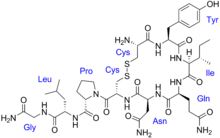- Contraction stress test
-
A contraction stress test (CST) is performed near the end of pregnancy to determine how well the fetus will cope with the contractions of childbirth. The aim is to induce contractions and monitor the fetus to check for heart rate abnormalities using a cardiotocograph.
Contents
Procedure
Nipple Stimulation
This is a procedure that relies on endogenous release of oxytocin following nipple stimulation, and is conducted by the patient. The nurse instructs the patient on the procedure, as follows. One nipple is massaged gently through clothing until a contraction begins, or for a maximum of 2 minutes. If at least 3 contractions in 10 minutes is not achieved, then the patient rests for 5 minutes and the other nipple is stimulated. [1][2]
Oxytocin Challenge Test (OCT)
If adequate contractions (at least 3 in 10 minutes) cannot be achieved with nipple stimulation, an oxytocin challenge test may be performed. It involves the intravenous administration of exogenous oxytocin to the pregnant woman. The target is to achieve around three contractions every ten minutes. [1][2]
Interpretation
*Positive: presence of late decelerations with at least 50% of the contractions
*Negative: no late or significant variable decelerations
*Equivocal—Suspicious: presence of late decelerations with fewer than 50% of contractions) or significant variable decelerations
*Equivocal—Tachysystole: Presence of contractions that occur more frequently than every 2 minutes or last longer than 90 seconds in the presence of late decelerations
*Equivocal—Unsatisfactory: Fewer than three contractions occur within 10 minutes, or a tracing quality that cannot be interpreted
Results & Efficacy
The CST is used for its high negative predictive value. A negative result is highly predictive of fetal wellbeing and tolerance of labor. The test has a poor positive predictive value with false-posiive results in as many as 30% of cases. [3][2]
History
The CST was the first antenatal surveillance test that was developed after the development of the cardiotocograph.[2] The oxytocin challenge test was first described in 1972[4] and was standardised in 1975 when the parameters of contraction number and frequency were given.
Historically, a CST was done after a non reactive NST. Today, a biophysical profile (BPP) is usually performed.
Contraindications
This "stress test" is usually not performed if there are any signs of premature birth or placenta praevia. Other contraindications include but are not limited to previous uterine incision with scarring, previous myomectomy entering the uterine cavity, PROM and incompetent cervix.
References
- ^ a b American College of Obstetricians and Gynecologists (ACOG). (1999). Antepartum fetal surveillance (Practice Bulletin No. 9). Washington, DC: Author.
- ^ a b c d Association of Women’s Health, Obstetric, and Neonatal Nurses (2005). Audrey Lyndon, Linda Usher Ali. ed. Fetal Heart Monitoring: Principles and Practices (3rd ed.). Dubuque, IA: Kendall/Hunt Publishing Co. ISBN 9780757562341.
- ^ Lagrew, D. C., Jr. (1995). The contraction stress test. Clinical Obstetrics and Gynecology, 38(1), 11–25
- ^ Ray M, Freeman R, Pine S, Hesselgesser R (September 1972). "Clinical experience with the oxytocin challenge test". Am. J. Obstet. Gynecol. 114 (1): 1–9. PMID 4637035.
External links
- Contraction Stress Test at webmd.com
Obstetrical surgery and other procedures (ICD-9-CM V3 72-75, ICD-10-PCS 1) Diagnostic sampling: fetal tissue (Chorionic villus sampling · Amniocentesis) · blood (Triple test · Percutaneous umbilical cord blood sampling · Apt test · Kleihauer-Betke test) · Lecithin-sphingomyelin ratio · Fetal fibronectin test
obstetric ultrasonography: Nuchal scan · Biophysical profile (Amniotic fluid index)
other medical imaging: Fetoscopy
Cardiotocography · (Nonstress test) · Vibroacoustic stimulation
challenge: Contraction stress test
Leopold's maneuversIntervention Delivery Vaginal deliveryInduction (Artificial rupture of membranes/Amniotomy) · Episiotomy · Symphysiotomy · Forceps in childbirth · Ventouse in childbirth
shoulder dystocia (McRoberts maneuver, Woods' screw maneuver, Zavanelli maneuver) · Manual placenta removalPostpartum hemorrhagePregnancy and childbirth Planning Conception Testing Prenatal AnatomyProceduresChildbirth PreparationRolesDeliveryPostpartum Obstetric history Categories:- Obstetrical procedures
- Medical tests
Wikimedia Foundation. 2010.

